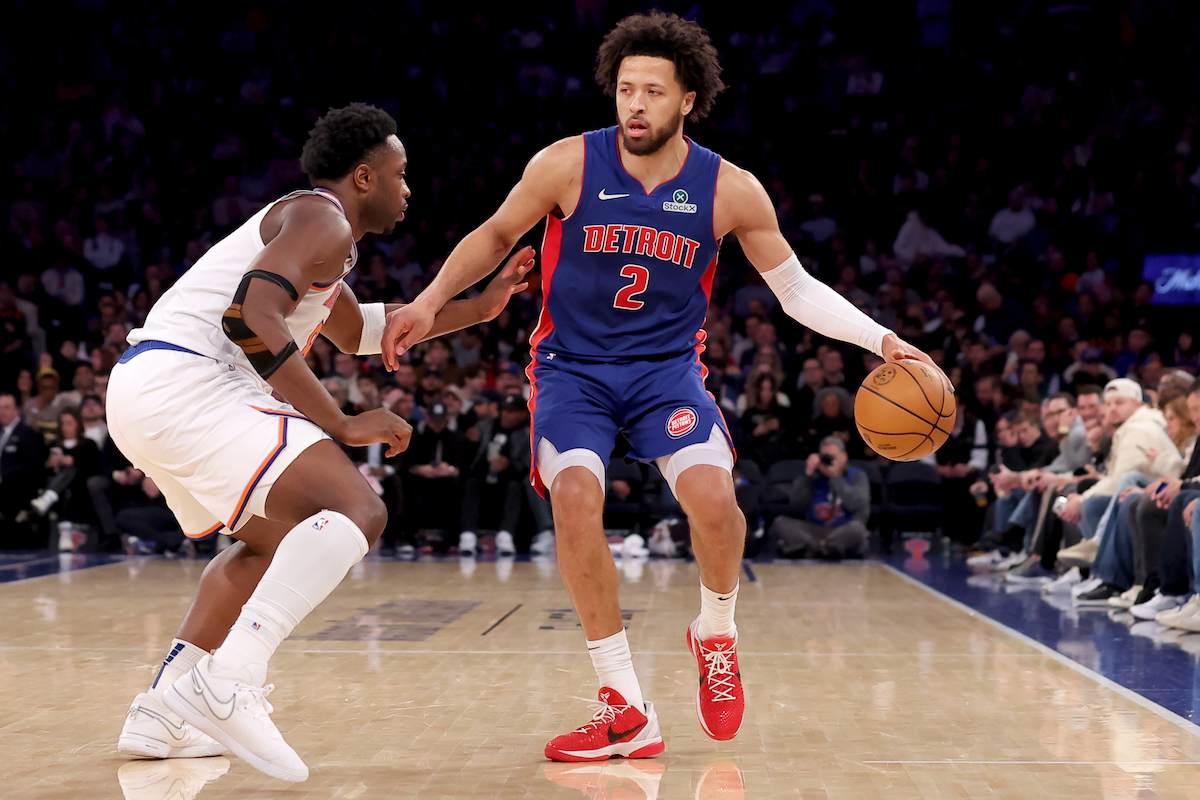
During Cade Cunningham’s 29-point second-half explosion inside Madison Square Garden Monday night, the 6-foot-6 guard gave the New York Knicks buckets in a flurry of ways.
He sunk midrange pull-ups. He sprayed home triples off the catch and bounce. He withstood contact and navigated limbs to finish around the rim. He drew the occasional foul for a trip to the charity stripe. It was a masterful display of scoring en route to an impressive 124-119 victory, the type of effort that’s become commonplace as Cunningham stares down an inaugural All-Star berth next month.
Though Cunningham’s fourth season (and third healthy one) hasn’t borne witness to some gargantuan, unforeseen leap, it does coincide with the Detroit Pistons’ return to relevancy and feature various incremental improvements. His floor vision and decision-making are sharper. His defensive consistency and imprint have perked up. He better applies his sturdy frame to score in the paint. His comfort as an outside shooter is blossoming.
They’re a bunch of minor areas of growth coalescing to make him a more complete player, one who sits 25th in Estimated Plus-Minus (plus-3.3) and 18th in Estimated Wins (5.2). But that last point of development — the long ball — is what most consistently pops as the massive difference offensively between Cunningham before 2024-25 and Cunningham today.
Cunningham Is A Much Improved Shooter
Drilling a career-best 38.2 percent from deep on a career-high 8.9 attempts per 100 possessions, he is a vastly more confident and impactful marksman. Against the Knicks, he netted four 3-pointers, his 11th such outing with at least that many, which established a new single-season high-water mark for the 22-year-old in just 36 games.
Specifically, Cunningham is prospering at new heights as a pull-up shooter beyond the arc. Through three seasons, pull-up triples never comprised more than 14.7 percent of his shot diet and he never made more than 32.5 percent of them, per NBA.com. His 14.7 percent rate also occurred in 2022-23, when he played only 12 games. During two healthy campaigns, the number to beat was 12.5 percent.
This year, it’s up to 21.1 percent and he’s splashing home 37.5 percent of his pull-up threes. Both the volume and efficiency have spiked as he unlocks new aggression and bravado while boogying off the bounce. That skill and the ripple effect of its potency were on display across a handful of possessions during Monday’s fourth quarter.
Early in the period, Cunningham sauntered around an Isaiah Stewart pick with Karl-Anthony Towns backpedaling ahead of him and Mikal Bridges in hot pursuit to his rear. But Cunningham was not rattled by Bridges’ imminent arrival or enticed by the space Towns’ descending shuffle presented him. He set his feet, cast a smooth jumper and laced the nylon.
Beyond the sheer star-level shot-making, his quick release and elevated arc resonate. Cunningham’s previously struggled with a flat shot and to cleanly deliver against tight contests. Neither proved an issue, and he’s clearly worked to remedy them this season. More often, he’s heightening his arc or accelerating his release to account for oncoming defenders. The diversity and gaul of his pull-up threes are burgeoning.
The Cunningham of old may see Towns retreating, sense Bridges recovering and flow downhill, using his frame to try and chisel space against the slender Bridges in the midrange. But this version of Cunningham is a different caliber of shooter — with more options in his offensive tool belt — who lets it rip when he sees defensive coverage like that.
Seventy seconds later, he snared a handoff and used a screen from Stewart to square up toward the basket. Now cognizant of Cunningham’s pull-up pizazz, Towns was again in coverage and elected to play near the level. Yet the silky shooting center was slow making that decision and granted his counterpart room to veer middle and convert an acrobatic, southpaw score.
Without context, the culprit for that breakdown is Towns’ tardy arrival. But there is always context preceding a singular play and dictating how defenses operate. Towns would not have scurried to the level if Cunningham had not announced himself as a threat from distance a couple possessions earlier and over the course of the entire season.
Were he not now adept hoisting threes off the dribble against pressurized contests, a vibe of hurried panic would not have lorded over Towns’ mental processing and opened a lane to the rim. Presumably, Towns would’ve sat back in drop and invited a midrange jumper or pocket pass to the undersized Stewart, who’s long struggled as a finisher.
Instead, Cunningham was free to contort around the 6-foot-2 Miles McBride. That wasn’t an easy shot, but the alternatives were probably even more daunting, had Cunningham’s newfound pull-up game not warped New York’s defensive priorities.
A possession later, with Towns still near the level, Detroit dialed up a Spain pick-and-roll. Towns was punctual, which left Stewart’s dive necessitating backside help. Guarding the popper/second screener in Simone Fontecchio, McBride briefly lurked at the nail against Stewart before passing off responsibility to OG Anunoby as the low man.
But that momentary roaming was long enough to leave McBride trailing the play and concede an angle inside for Fontecchio off the catch. Although Towns returned to the paint after corralling Cunningham, Stewart railroaded him from properly protecting the rim and spurred disarray for New York’s remaining nearby defenders. Anunboy fouled Fontecchio and the Italian drained both free throws.
New York’s adjustment to previously station Towns at the level as a response to Cunningham’s shooting set the stage for a counter from the Pistons. They knew the paint would be clear and prompt some conflicting decisions for the Knicks defense. All of it stemmed from the strain of Cunningham’s pull-up 3-ball.
Much later in the quarter, Detroit, sporting a two-point lead, diagrammed a Pistol action for Cunningham. He’s long excelled operating from the wings with an empty corner and that didn’t change on this instance. As he received the pitch back from Stewart, Anunoby chased him over the top.
Such a strategy rammed himself into Stewart’s concrete frame and gave Cunningham single coverage, with a head of steam, against the slow-footed Towns, who was approaching the level of the screen (again). The All-Star big man couldn’t slide to cut off Cunningham’s angle baseline and hip-checked his way into a foul. The career 84 percent free-throw shooter knocked down both to double Detroit’s advantage.
A season ago, I’m skeptical Anunoby elects to track Cunningham over the top or that Towns presses up so far. Anunoby probably ducks under, trusts in his own capacity to challenge any immediate jumper and doubts Cunningham’s willingness to launch in the vicinity of his sprawling, 7-foot-2 wingspan. Or, maybe, Towns plays deeper and New York squeezes Detroit’s star into the midrange.
Whatever the path, it doesn’t involve an emphasis to eliminate a three on the handoff. Nowadays, it does — and the Knicks aren’t alone treating Cunningham like this. He’s evolved into a level of shooter who often bends defense in that manner.
When he entered the league 3.5 years ago, he could always get to his spots on the floor. Nothing has changed there. But “his” spots and how he capitalizes upon frequenting them have expanded. He holsters more options, tidier processing and a wider dashboard to punish defenses, much of which stems from his shooting growth. Monday’s momentous win and the process behind it were real-time testimonials.







